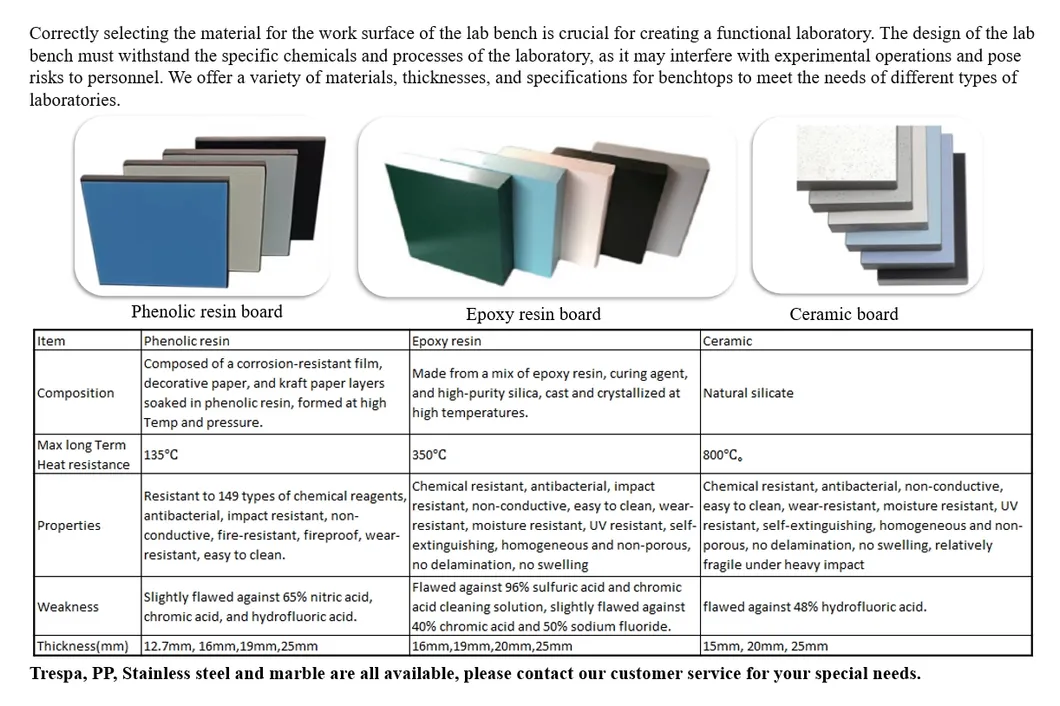

What are Steel Wood Laboratory Furniture Materials ?
Main Frame of laboratory furniture materials : Constructed of 40*60mm high-quality square steel, surface treated with pickling, phosphating, and uniform gray-white epoxy spraying for chemical rust prevention, ensuring resistance to acid and alkali corrosion, excellent load-bearing capacity, and long service life.
Worktop: Made of laboratory-grade solid core phenolic resin board etc, surface treated for a smooth, non-porous finish, resistant to acids and alkalis, and corrosion. Milled edges ensure the worktop meets high-quality laboratory industry standards for corrosion resistance and waterproofing.
Door Panels: Made of high-quality environmentally friendly melamine board; all edges are treated with high-quality PVC waterproofing, and all four corners are rounded.
Cabinet Body of Laboratory Furniture Materials: Made of high-quality environmentally friendly melamine board; all edges are sealed with high-quality PVC waterproofing. The cabinet body panels use a detachable three-in-one connection, providing a stable structure, excellent load-bearing capacity, and easy disassembly, ideal for the unique working environment of a laboratory.
Drawers: Drawer front panels are the same material as the door panels; bottom panels are generally made of high-quality MDF; other materials are the same as the cabinet body.
Modible Back Panel: Made of high-quality MDF, all edges are sealed with high-quality PVC for waterproofing. It is movable and detachable for easy use.
Hinges: Typically stainless steel hinges. The cabinet door closes automatically at a 15-degree angle to the cabinet surface, offering good elasticity, an attractive appearance, quiet operation, and a long service life.
Guide Rails: Three-section noise-reducing guide rails with a black epoxy resin electrostatic spray coating (galvanized). They are corrosion-resistant, easy for personnel to operate while holding items, and suitable for use in special laboratory environments.
Handles: Handles are made of stainless steel, aluminum alloy, or corrosion-resistant PVC. They are molded, chemically treated, aesthetically pleasing, and ergonomically designed.
Countertops of Laboratory Furniture Materials :

Special Functions of Laboratory Furniture Materials :
Carrying experimental equipment: Provide a stable platform for placing microscopes, centrifuges, scales, reaction devices, and other instruments.
Corrosion resistance: For chemical reagents such as acids, alkalis, and organic solvents, countertops are often treated with anti-corrosion measures (such as epoxy resin boards and solid psychological boards).
High temperature resistance: Some countertop materials (such as ceramic panels and stainless steel edging) can withstand short-term high temperatures (such as alcohol lamps and electric furnaces).
Support and load-bearing
Steel frame: High carbon steel or stainless steel brackets provide strong support, with a load-bearing capacity of up to 300kg~500kg/m ² (depending on the design).
Adjustable foot pads: adapt to uneven ground and keep the tabletop level.
Storage and organization
Lower cabinet: Steel wood structure is often paired with drawers, shelves, or reagent cabinets to store experimental consumables, tools, or hazardous materials (requiring fire-resistant design).
Pipeline management: Reserve holes or channels for concealed layout of water, electricity, gas, and data lines.
What are Steel Wood Laboratory Furniture Materials ?
Main Frame of laboratory furniture materials : Constructed of 40*60mm high-quality square steel, surface treated with pickling, phosphating, and uniform gray-white epoxy spraying for chemical rust prevention, ensuring resistance to acid and alkali corrosion, excellent load-bearing capacity, and long service life.
Worktop: Made of laboratory-grade solid core phenolic resin board etc, surface treated for a smooth, non-porous finish, resistant to acids and alkalis, and corrosion. Milled edges ensure the worktop meets high-quality laboratory industry standards for corrosion resistance and waterproofing.
Door Panels: Made of high-quality environmentally friendly melamine board; all edges are treated with high-quality PVC waterproofing, and all four corners are rounded.
Cabinet Body of Laboratory Furniture Materials: Made of high-quality environmentally friendly melamine board; all edges are sealed with high-quality PVC waterproofing. The cabinet body panels use a detachable three-in-one connection, providing a stable structure, excellent load-bearing capacity, and easy disassembly, ideal for the unique working environment of a laboratory.
Drawers: Drawer front panels are the same material as the door panels; bottom panels are generally made of high-quality MDF; other materials are the same as the cabinet body.
Modible Back Panel: Made of high-quality MDF, all edges are sealed with high-quality PVC for waterproofing. It is movable and detachable for easy use.
Hinges: Typically stainless steel hinges. The cabinet door closes automatically at a 15-degree angle to the cabinet surface, offering good elasticity, an attractive appearance, quiet operation, and a long service life.
Guide Rails: Three-section noise-reducing guide rails with a black epoxy resin electrostatic spray coating (galvanized). They are corrosion-resistant, easy for personnel to operate while holding items, and suitable for use in special laboratory environments.
Handles: Handles are made of stainless steel, aluminum alloy, or corrosion-resistant PVC. They are molded, chemically treated, aesthetically pleasing, and ergonomically designed.
Countertops of Laboratory Furniture Materials :

Special Functions of Laboratory Furniture Materials :
Carrying experimental equipment: Provide a stable platform for placing microscopes, centrifuges, scales, reaction devices, and other instruments.
Corrosion resistance: For chemical reagents such as acids, alkalis, and organic solvents, countertops are often treated with anti-corrosion measures (such as epoxy resin boards and solid psychological boards).
High temperature resistance: Some countertop materials (such as ceramic panels and stainless steel edging) can withstand short-term high temperatures (such as alcohol lamps and electric furnaces).
Support and load-bearing
Steel frame: High carbon steel or stainless steel brackets provide strong support, with a load-bearing capacity of up to 300kg~500kg/m ² (depending on the design).
Adjustable foot pads: adapt to uneven ground and keep the tabletop level.
Storage and organization
Lower cabinet: Steel wood structure is often paired with drawers, shelves, or reagent cabinets to store experimental consumables, tools, or hazardous materials (requiring fire-resistant design).
Pipeline management: Reserve holes or channels for concealed layout of water, electricity, gas, and data lines.